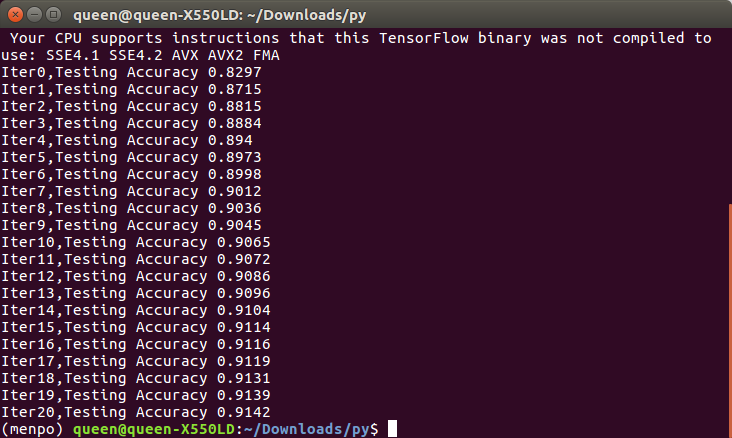MINIST数据集分类简单版本(03-3)
MNIST_data数据 百度网盘链接:https://pan.baidu.com/s/19lhmrts-vz0-w5wv2A97gg
提取码:cgnx
# -*- coding: UTF-8 -*- import tensorflow as tf from tensorflow.examples.tutorials.mnist import input_data #载入数据集 mnist=input_data.read_data_sets("MNIST_data", one_hot=True) #每个批次的大小 batch_size=100 #计算一共有多少个批次 n_batch=mnist.train.num_examples // batch_size #定义两个placeholder x=tf.placeholder(tf.float32,[None,784]) y=tf.placeholder(tf.float32,[None,10]) #创建一个简单的神经网络 W=tf.Variable(tf.zeros([784,10])) b=tf.Variable(tf.zeros([1,10])) prediction=tf.nn.softmax(tf.matmul(x,W)+b) #二次代价函数 loss = tf.reduce_mean(tf.square(y-prediction)) #使用梯度下降法优化 train_step=tf.train.GradientDescentOptimizer(0.2).minimize(loss) #初始化变量 init=tf.global_variables_initializer() #结果放在一个布尔型列表中 correct_prediction=tf.equal(tf.argmax(y,1), tf.argmax(prediction,1)) #argmax函数返回一维向量中最大值所在的位置 #求准确率 accuracy=tf.reduce_mean(tf.cast(correct_prediction,tf.float32)) with tf.Session() as sess: sess.run(init) for epoch in range(21):#把所有图片训练21遍 for batch in range(n_batch):#把所有图片都训练一遍 batch_xs,batch_ys=mnist.train.next_batch(batch_size) sess.run(train_step,feed_dict={x:batch_xs, y:batch_ys}) acc=sess.run(accuracy,feed_dict={x:mnist.test.images, y:mnist.test.labels}) print("Iter"+str(epoch)+",Testing Accuracy "+str(acc))
运行结果

上面代码有很多地方都可以优化,如何介绍把识别的准确率提高到95%以上




 浙公网安备 33010602011771号
浙公网安备 33010602011771号